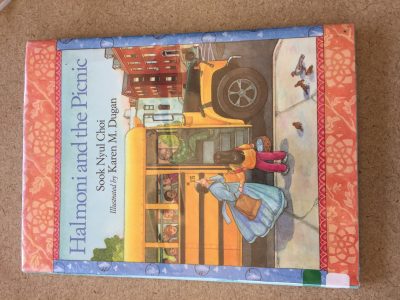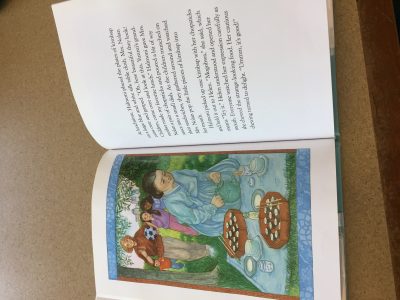

Author: Sook Nyul Choi
Illustrator: Karen M. Dugan
Length: 26 pages
Genre: Realistic fiction
Analysis:
Halmoni and the Picnic is a touching book about Yunmi and her grandmother Halmoni, who immigrated from Korea. Yunmi’s class was having a field trip to enjoy a picnic, and they need a chaperone. Halmoni is very shy and doesn’t like to speak English for fear of getting made fun of. Yunmi invites Halmoni to chaperone their field trip, hoping that it will make Halmoni feel more welcomed, but Yunmi also fears that her classmates might make fun of the different kinds of food Halmoni brings. The field trip goes wonderfully and Halmoni feels very happy and included.
This book conveys a very important message about the journey of immigrants and the power of acceptance and respect for other cultures. The text in this book appropriately addresses differences in cultures and recognizes how hard it can be getting used to a different culture. On page 7, Halmoni scolds Yunmi for saying hello to a grownup, and Yunmi respectfully tells Halmoni that in America, it is rude to not greet people you pass. The text skillfully recognizes other cultures and demonstrates how to welcome diversity, while also discussing the difficulties of immigration. It can be tricky to talk about difficult subjects such as immigration and inclusion without being racist or encouraging stereotypes. Luckily, the author, Sook Nyul Choi, grew up in North Korea and moved to the United States for college, so she is well qualified to talk about this culture, and does so beautifully.
The illustrations help paint this picture of acceptance and diversity. Every picture is in a frame which are designed with Asian artwork. This helps the reader get the feel for Yunmi and Halmoni’s world, and helps them feel like they are catching a glimpse of it. Another very important thing to note pertaining to the illustrations is the diversity. The students at Yunmi’s school are many different races, and they are shown to all be participating and active. This helps the reader visualize what inclusion can look like. The illustrations beautifully complement the text.
Overall, this book is a wonderful window for the reader. It allows them to witness a very real and common experience that families have, moving to the US. It enables the reader to sympathize with them, while also appreciating their culture and understanding how to embrace it.
